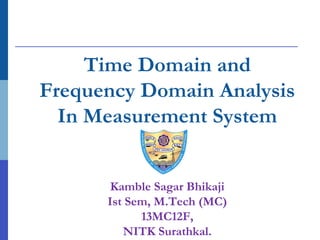
ppt on Time Domain and Frequency Domain Analysis
- 1. Time Domain and Frequency Domain Analysis In Measurement System Kamble Sagar Bhikaji Ist Sem, M.Tech (MC) 13MC12F, NITK Surathkal.
- 2. Contents 1. Introduction 2. Time Domain Analysis 3. Frequency Domain Analysis 4. Example- Voltage measurement from a Solar panel 5. Summary 6. References
- 3. Introduction: Measurement Systems It is required to develop mathematical tools that will allow us to quantitatively analyze measurement systems. Figure 1. General structure of an engineering measurement system (Bentley, 1993)
- 4. Introduction Two types of mathematical tools: 1) Time Domain Analysis - Time domain analysis examines the amplitude vs. time characteristics of a measuring signal. 2) Frequency Domain Analysis - Frequency domain analysis replaces the measured signal with a group of sinusoids which, when added together, produce a waveform equivalent to the original. - The relative amplitudes, frequencies, and phases of the sinusoids are examined.
- 5. Time Domain Analysis In time-domain analysis the response of a dynamic system to an input is expressed as a function of time c(t). It is possible to compute the time response of a system if the nature of input and the mathematical model of the system are known. The time response of a system can be obtained by solving the differential eq. governing the system. Alternatively, the response c(t) can be obtained from the transfer function of the system and the input to the system
- 6. Time Domain Analysis For a closed loop transfer function, C(s)/R(s)= G(s)/[1+G(s)H(s)] Response in s-domain, C(s) = R(s)*M(s) Response in t-domain, c(t) = InvLap[C(s)]
- 7. Time Domain Analysis Time Domain Specifications For specifying the desired performance characteristics of a measurement control system. These characteristics of a system of any order may be specified in terms of transient response to a unit step input signal. The response of a second order system for a input is, 2 2 2 ( ) ( ) 2 n n n C s R s s s w zw w = + +
- 8. Time Domain Analysis Time Domain Specifications 1 Delay time 2 Rise time 3 Peak time 4 Peak overshoot 5 Settling time 6 Steady-state error
- 9. Time Domain Analysis Time Domain Specifications 1. Delay time : It is the time required for the response to reach 50% of the final value in first attempt. 2. Rise time : It is the time required to rise from 0 to 100% of the final value for the under damped system. 3. Peak time : It is the time required for the response to reach the peak of time response or the peak overshoot. 4. Settling time : It is the time required for the response to reach and stay within a specified tolerance band ( 2% or 5%) of its final value. 5.Peak overshoot : It is the normalized difference between the time response peak and the steady output and is defined as, 6. Steady-state error: It indicates the error between the actual output and desired output as ‘t’ tends to infinity.
- 10. Frequency Domain Analysis Introduction Advantages - Stability of closed loop system can be estimated - Transfer function of complicated systems can be determined experimentally by frequency tests - Effects of noise disturbance and parameter variations are relatively easy to visualize. - Analysis can be extended to certain nonlinear control systems. VIDEO
- 11. Frequency Domain Analysis Frequency Domain Specifications 1 Resonant Peak 2 Resonant Frequency 3 Bandwidth 4 Cut-off rate 5 Gain Margin 6 Phase Margin
- 12. Frequency Domain Analysis Frequency Domain Specifications 1 Resonant Peak- Maximum value of the closed loop transfer function. 2 Resonant Frequency- Frequency at which resonant peak occurs. 3 Bandwidth- range of frequencies for which the system normalized gain is more than -3db. 4 Cut-off rate- It is the slop of the log-magnitude curve near the cut off frequency. 5 Gain Margin- The value of gain to be added to system in order to bring the system to the verge of instability. 6 Phase Margin- Additional phase lag to be added at the gain cross over freq. in order to bring the system to the verge of instability.
- 13. Frequency Domain Analysis Frequency Response Plots Frequency domain analysis of a system can be carried either analytically or graphically. The various graphical techniques are 1 Bode Plot 2 Polar Plot 3 Nichols Plot 4 M and N circles Frequency response plots are used to determine the frequency domain specifications, to study the stability of the system.
- 14. Example- Measurement from a Solar panel VIDEO
- 15. Summary Every measurement system require analysis of its features or performance to work as a system. Time domain analysis gives the behaviour of the signal over time. This allows predictions and regression models for the signal. Frequency Analysis is much easier. Some equations can't be solved in time domain while they can be solved easily in frequency domain.
- 16. References Control Systems- By A. Nagoor Kani, 2nd Edition, Chapter 3 and 4. https://6002x.mitx.mit.edu/wiki/view/TimeDom ainVersusFrequencyDomainAnalysis Frequency Domain in Measurements – NIglobal channel : YouTube. Control Systems Lectures - Time and Frequency Domain : YouTube.
- 17. Any Questions ?